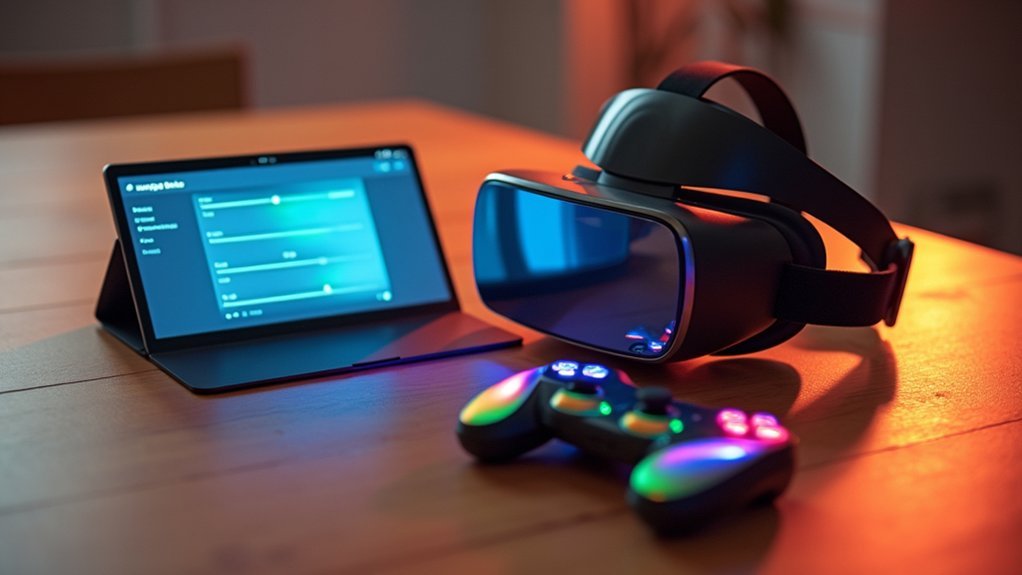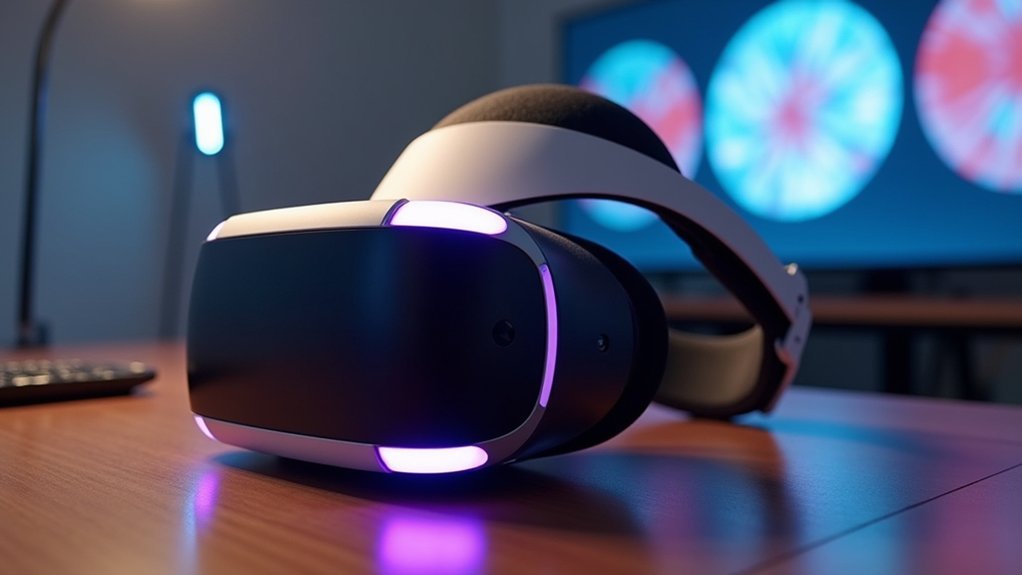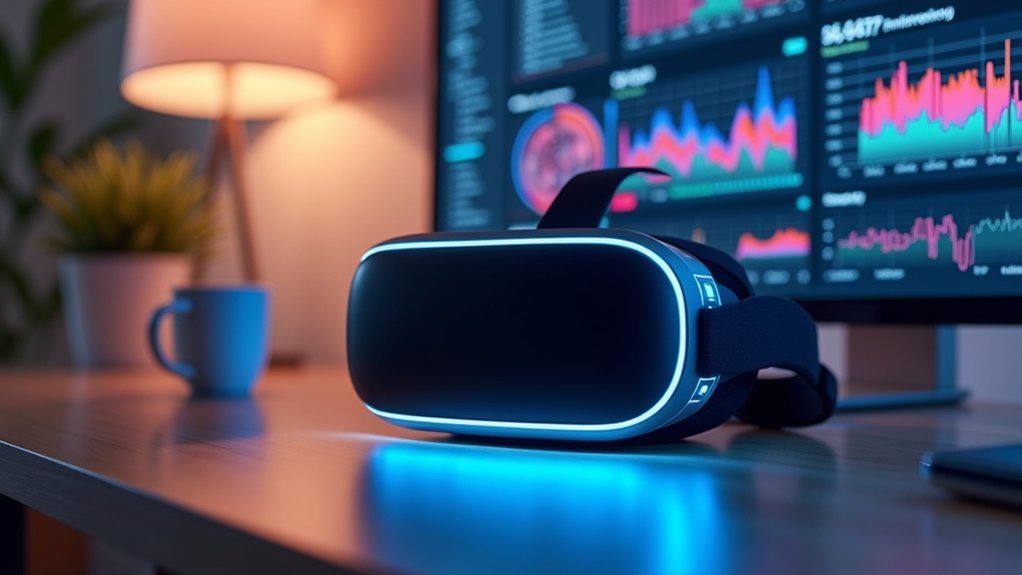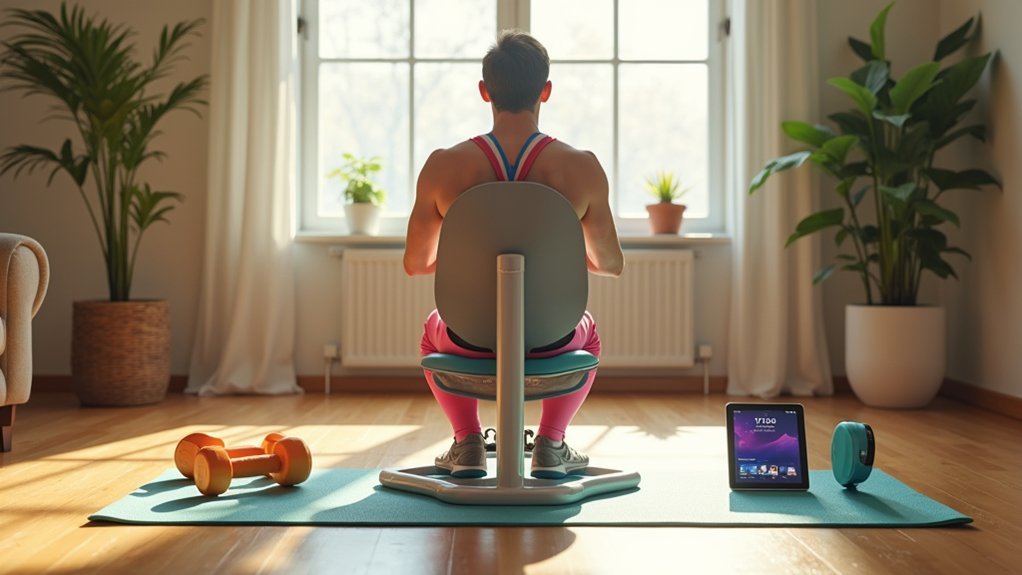You’ll find seven essential epilepsy safety features in virtual reality that protect against seizure triggers. These include customizable visual settings to adjust brightness below 60 cd/m², motion sensitivity controls with teleportation mechanics, pre-screening tools like the Harding test, real-time seizure trigger alerts, emergency disconnection protocols, standardized developer content guidelines, and user-controlled environmental modifications. These features work together through biometric monitoring, instant warnings, and automatic session termination to guarantee your safety during VR experiences while exploring these protective technologies further.
Customizable Visual Settings and Brightness Controls

When you’re traversing virtual reality environments, customizable visual settings serve as your first line of defense against photosensitive seizure triggers. These vital features allow you to adjust brightness, contrast, and saturation levels specifically tailored to your sensitivity needs.
Brightness controls become particularly important for VR safety, enabling you to reduce screen luminance below 60 cd/m² when necessary.
You’ll find that modern VR applications increasingly offer options to modify flashing light frequencies, keeping them below the critical 3 Hz threshold. This customization empowers you to pre-screen content for potentially harmful visuals before full immersion.
Motion Sensitivity Reduction Features
Beyond visual adjustments, motion sensitivity reduction features form an essential protective layer for VR users prone to seizures.
You’ll find adjustable comfort settings that let you modify motion speed and intensity, preventing overstimulation that could trigger episodes. Most VR environments now incorporate teleportation and snap-turning mechanics instead of continuous movement, considerably reducing discomfort risks.
You can gradually introduce yourself to motion through user-controlled settings, allowing proper acclimation before engaging intense scenarios.
Many applications offer “comfort mode” options that limit rapid visual changes while maintaining stable viewpoints. These features reduce symptom triggers in sensitive individuals.
Comfort mode settings in VR applications minimize rapid visual changes and maintain stable viewpoints to reduce seizure triggers.
Research confirms that implementing thorough user-controlled settings for motion sensitivity greatly enhances VR safety and inclusivity, making virtual experiences accessible for users with seizure concerns.
Pre-Screening and Photosensitivity Detection Tools

You’ll need to complete a thorough medical history assessment before using VR, focusing specifically on any previous seizure episodes or epilepsy diagnoses.
Your healthcare provider should administer standardized photosensitivity testing protocols, such as the Harding test, to determine your specific light sensitivity thresholds.
This pre-screening process identifies essential risk factors including your response to flashing lights, visual patterns, and luminance levels that could trigger seizures in VR environments.
Medical History Assessment
Although virtual reality offers immersive experiences, you’ll need thorough medical history assessment before diving into VR environments if you have epilepsy. Your healthcare provider should document previous seizure patterns, triggers, and medication effectiveness to establish a detailed seizure management plan.
During assessment, you’ll undergo photosensitivity testing using tools like the Harding test or Epilepsy Action app. These detect your susceptibility to visual triggers that could prompt seizures in VR settings. Since only 3% of epilepsy patients have photosensitive epilepsy, proper screening identifies your specific risk level.
Your medical history review should include frequency of seizures, known environmental triggers, and current treatment protocols. This information guides VR safety recommendations, including minimizing flashing lights and customizing visual settings to match your individual tolerance levels for safe virtual experiences.
Photosensitivity Testing Protocols
Thorough pre-screening protocols form the foundation of safe VR experiences for people with epilepsy.
You’ll need extensive photosensitivity testing before entering VR environments to identify potential seizure risks. The Harding test and Epilepsy Action app serve as essential detection tools, evaluating your reactions to flashing lights and visual patterns.
These assessments help determine your sensitivity thresholds and guide personalized safety settings. You should undergo testing that examines responses to various light frequencies and luminance levels, particularly those below 3 Hz and exceeding 60 cd/m².
Documentation of your test results enables VR developers to customize environments accordingly.
Regular monitoring of user experiences provides valuable feedback for refining protocols. You’ll benefit from periodic reassessments, as photosensitivity can change over time, ensuring continued safe VR participation.
Risk Factor Identification
Building on these testing foundations, effective risk factor identification requires a thorough approach that extends beyond basic photosensitivity assessment. You’ll need to evaluate multiple factors that contribute to VR-induced seizure susceptibility. Your seizure history provides essential baseline information, while genetic predisposition and current medications greatly influence your response to visual stimuli.
| Risk Category | Assessment Method | Safety Measures |
|---|---|---|
| Medical History | Seizure frequency documentation | Personalized usage guidelines |
| Photosensitive Epilepsy | Harding test screening | Light intensity controls |
| Medication Effects | Drug interaction analysis | Adjusted exposure limits |
| Environmental Factors | Stress and fatigue evaluation | Usage time restrictions |
Comprehensive risk factor identification enables developers to implement targeted safety measures, ensuring your VR experience remains both engaging and secure through personalized protection protocols.
Real-Time Seizure Trigger Alerts

When you’re using VR, real-time seizure trigger alerts actively monitor visual content for photosensitive patterns that could provoke seizures.
You’ll receive instant warnings the moment the system detects potentially harmful stimuli, giving you vital seconds to respond.
These systems also include emergency response protocols that can automatically terminate your VR session and alert caregivers if dangerous patterns persist.
Photosensitive Pattern Detection
As VR technology advances, photosensitive pattern detection systems have become essential safety mechanisms that actively monitor visual content for seizure-triggering elements.
These sophisticated detection algorithms continuously analyze your VR environment, identifying dangerous patterns that could affect individuals with photosensitive epilepsy. The systems monitor flickering lights, rapid brightness changes, and color contrasts in real-time to protect your safety.
When potentially harmful visual stimuli are detected, seizure trigger alerts immediately notify you, allowing quick response to prevent seizures.
VR safety guidelines require these systems to flag content exceeding 3 Hz flashing rates or luminance levels above 60 cd/m². You’ll benefit from ongoing research that refines detection accuracy through user feedback, creating more accessible VR experiences for those with seizure histories.
Instant Warning Systems
Real-time seizure trigger alerts represent the next evolution beyond pattern detection, instantly warning you when biometric sensors identify physiological changes that precede seizures.
These instant warning systems monitor your heart rate, muscle tension, and other essential signs to detect seizure triggers before they occur. Machine learning algorithms analyze your personal data patterns, improving accuracy over time by learning from previous seizure events.
When the system detects potential triggers, it immediately adjusts visual stimuli or pauses your VR experience entirely.
This protection proves especially important for individuals with photosensitive epilepsy, who face heightened risks in immersive environments. Real-time alerts guarantee you can safely enjoy VR experiences while standardized protocols continue developing to establish consistent safety measures across all VR platforms.
Emergency Response Protocols
Emergency response protocols activate instantly once your VR system detects seizure onset, automatically stopping your session and initiating a cascade of protective measures.
Your wearable technology continuously monitors physiological signals, triggering real-time seizure trigger alerts that immediately notify designated emergency contacts.
These emergency response protocols don’t just shut down your VR environment—they provide critical information about your condition to caregivers and medical professionals.
You’ll benefit from customizable settings that adapt to your specific seizure patterns and triggers, ensuring protocols respond appropriately to your unique needs.
The user-friendly interface keeps you informed throughout the process while minimizing confusion during critical moments.
Your emergency contacts receive detailed alerts including seizure duration, intensity, and your current location, enabling them to provide targeted assistance when you need it most.
Emergency Disconnection and Safety Protocols
When you’re experiencing the onset of a seizure while using VR technology, quick emergency disconnection features can be lifesaving. These systems allow you to instantly exit virtual environments, minimizing exposure to harmful seizure triggers.
Safety protocols must include customization options for your VR experience. You can adjust brightness, contrast, and visual effects to reduce photosensitivity risks. Warning systems alert you to potential triggers like flashing lights before they occur.
| Safety Feature | Function | Benefit |
|---|---|---|
| Emergency Disconnect | Instant VR exit | Rapid trigger removal |
| Visual Controls | Brightness/contrast adjustment | Reduced photosensitivity |
| Warning Alerts | Pre-trigger notifications | Proactive seizure prevention |
Regular user testing guarantees these protocols meet safety standards from ISO and WHO guidelines, while emergency access to medical assistance remains immediately available throughout your VR sessions.
Standardized Content Guidelines for Developers
Beyond implementing emergency protocols, developers must follow standardized content guidelines to prevent seizure triggers from appearing in VR environments altogether.
You should avoid or minimize flashing lights and visual patterns exceeding 3 Hz or 60 cd/m² luminance to protect users with photosensitive epilepsy. When creating VR applications, test your content using established tools like the Harding test or Epilepsy Action app to identify potentially harmful elements.
You’ll want to adhere to guidelines from ISO, IEC, and WHO organizations for safer experiences.
Essential safety features include implementing user warnings and providing customizable settings that let users adjust brightness, contrast, and saturation levels. These accommodations guarantee your VR applications remain accessible while minimizing epilepsy risks for all users.
User-Controlled Environmental Modifications
Since each person’s sensitivity to visual stimuli varies greatly, you should implement thorough user-controlled environmental modifications that allow individuals to tailor their VR experience according to their specific needs.
These safety features enable users with photosensitive epilepsy to adjust light intensity, brightness, contrast, and saturation settings in real-time.
You’ll want to create user-friendly interfaces that facilitate quick modifications when users experience discomfort or detect potential seizure triggers.
Effective user-controlled modifications empower individuals by providing immediate access to adjustable settings that minimize risks associated with flashing lights and rapid imagery changes.
Immediate access to customizable visual controls empowers users to minimize epilepsy risks from flashing lights and rapid imagery in VR environments.
Research confirms that giving users control over visual stimuli markedly enhances safety for people with epilepsy, making these customization options essential components of accessible VR design.
Frequently Asked Questions
Is VR Safe for People With Epilepsy?
You can use VR safely with epilepsy if you take proper precautions. You’ll need pre-screening, adjusted brightness settings, frequent breaks, and avoiding content with rapid flashing lights exceeding safety thresholds.
What Are Safety Considerations for Epilepsy?
You should avoid flashing lights, get adequate sleep, take medications consistently, limit alcohol consumption, manage stress levels, and wear medical identification. Always consult your doctor before making lifestyle changes.
What Can Virtual Reality Do for Safety?
You can customize brightness and contrast settings in VR to prevent seizure triggers. VR developers avoid flashing lights above 3 Hz, and platforms undergo safety testing to protect you from photosensitive epilepsy risks.
Is 3D Ok for Epilepsy?
You’ll face risks with 3D content if you have photosensitive epilepsy. Rapid motion and flashing images can trigger seizures. Consult your doctor first and limit sessions to avoid potential complications.





Leave a Reply